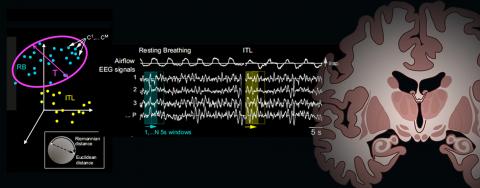
Relations between the nervous system and the respiratory system
MRSU 1158
-
Fédération
MRSU 1158 is dedicated to the study of relations between the nervous system and the respiratory system (“respiratory neurophysiology”). It mobilizes biological, histological, physiological, pharmacological, clinical and psychophysiological approaches, with an extensive use of biomathematics and modeling. Its research is highly translational, its close articulation with the department R3S of GH Pitié-Salpêtrière allowing bidirectional interactions between animal research and human research. The unit is led by Professor Similowski, with Professor Bodineau and Professor Straus as assistant directors. UMRS 1158 has a human laboratory (“respiratory pathophysiology laboratory”, Antonin Gosset building at La Salpêtrière), and an animal laboratory (“laboratory of physiology and plasticity of breathing control”, 7th floor of 91 bd de l’Hopital).
MRSU 1158 is a single-team unit, in which there are 3 main themes:
Cerebral Cortex and Respiration, Pr Similowski
with the study of the neurophysiological and psychophysiological mechanisms of dyspnea (Pr Morélot-Panzini), the study of the neurophysiology of acute respiratory failure (Pr Demoule), and the development, from a patent portfolio, of a “brain-ventilator” interface (Pr Raux). Also included in this theme are programs such as “Respiratory neurophysiology of phonation” (Pr Gatignol), “Cortical control of postural and respiratory interactions (Dr Attali),” control and respiratory sensations during exercise “(Dr. Laveneziana) or “respiration-cognition interactions” (Pr Similowski).
Automatic control of ventilation
– in animals (Pr Bodineau)
– in humans (Pr Straus)
With pharmacological and biomathematical valences (Brigitte Quenet and Rivals, ESPCI); this research theme particularly targets congenital central alveolar hypoventilation consecutive to mutation of the PHOX2B gene (“Ondine Syndrome”), with constant back and forth interactions between animal models and patients (“rare disease” reference center within the R3S department of the GH Pitié-Salpêtrière). Programs such as “interaction between stress and breathing” (Ms. Sevoz-Couche, CR Inserm) and “interactions between serotonergic systems and sex hormones during obstructive sleep apnea syndrome” (Ms. Fiamma, Dr. Cardot, Dr. Redolfi) are also part of this theme.
Neuroplasticity and respiratory neurostimulation
with a peripheral approach in animals and humans (implanted phrenic stimulation: Prof. Assouad and Pr Gonzalez-Bermejo), a physio-pharmacological medullary approach (Ms Vivodtzev, CR Inserm) and a central approach (inducible respiratory neuroplasticity, Ms. Marie-Cécile Nierat). In this theme, there are projects for the development and physiological and clinical validation of new technological approaches for implanted phrenic stimulation, in classical indications (high tetraplegia, central hypoventilations) and innovative ones (prevention of degenerative or iatrogenic diaphragmatic atrophy-artificial ventilation). There are also various projects evaluating new approaches to the induction of cortical respiratory neuroplasticity for the treatment of central hypoventilations and the treatment of dyspnea.
Director
-
Thomas SIMILOWSKI
Secretary
-
+33 (0)1 42 16 77 52
Autres tutelles
- Institut National de la Santé et de la Recherche Médicale | INSERM
- Sorbonne Université
Contact details
Adresse physique
75651 Paris Cedex 13
Adresse postale
75013 Paris
-
+33 (0)1 42 16 77 97
